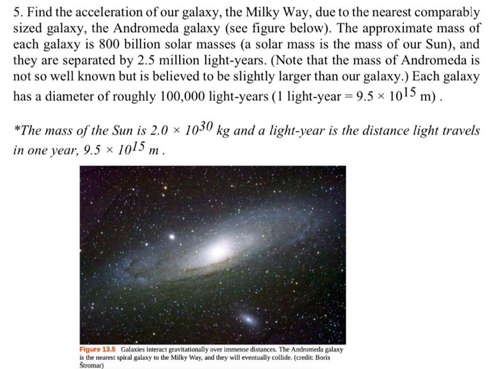5. Find the acceleration of our galaxy, the Milky Way, due to the nearest comparably sized galaxy, the Andromeda galaxy (see figure below). The approximate mass of cach galaxy is 800 billion solar masses (a solar mass is the mass of our Sun), and they are separated by 2.5 million light-years. (Note that the mass of Andromeda is not so well known but is believed to be slightly larger than our galaxy.) Each galaxy has a diameter of roughly 100,000 light-years (1 light-year = 9.5 × 1015 m). *The mass of the Sun is 2.0 × 1030 kg and a light-year is the distance light travels in one year, 9.5 × 1015 m .
5. Find the acceleration of our galaxy, the Milky Way, due to the nearest comparably sized galaxy, the Andromeda galaxy (see figure below). The approximate mass of cach galaxy is 800 billion solar masses (a solar mass is the mass of our Sun), and they are separated by 2.5 million light-years. (Note that the mass of Andromeda is not so well known but is believed to be slightly larger than our galaxy.) Each galaxy has a diameter of roughly 100,000 light-years (1 light-year = 9.5 × 1015 m). *The mass of the Sun is 2.0 × 1030 kg and a light-year is the distance light travels in one year, 9.5 × 1015 m .
University Physics Volume 1
18th Edition
ISBN:9781938168277
Author:William Moebs, Samuel J. Ling, Jeff Sanny
Publisher:William Moebs, Samuel J. Ling, Jeff Sanny
Chapter13: Gravitation
Section: Chapter Questions
Problem 42P: Astronomical observatrions of our Milky Way galaxy indicate that it has a mass of about 8.01011...
Related questions
Topic Video
Question

Transcribed Image Text:5. Find the acceleration of our galaxy, the Milky Way, due to the nearest comparably
sized galaxy, the Andromeda galaxy (see figure below). The approximate mass of
each galaxy is 800 billion solar masses (a solar mass is the mass of our Sun), and
they are separated by 2.5 million light-years. (Note that the mass of Andromeda is
not so well known but is believed to be slightly larger than our galaxy.) Each galaxy
has a diameter of roughly 100,000 light-years (1 light-year = 9.5 × 1015 m) .
*The mass of the Sun is 2.0 × 1030 kg and a light-year is the distance light travels
in one year, 9.5 × 1015 m .
Figure 135 Galaxies interact gravitationally over immense distances. The Andromeda galaxy
is the nearest spiral galaxy to the Milky Way, and they will eventually collide. (credit Boris
Seromar)
Expert Solution
This question has been solved!
Explore an expertly crafted, step-by-step solution for a thorough understanding of key concepts.
This is a popular solution!
Trending now
This is a popular solution!
Step by step
Solved in 3 steps with 3 images

Knowledge Booster
Learn more about
Need a deep-dive on the concept behind this application? Look no further. Learn more about this topic, physics and related others by exploring similar questions and additional content below.Recommended textbooks for you

University Physics Volume 1
Physics
ISBN:
9781938168277
Author:
William Moebs, Samuel J. Ling, Jeff Sanny
Publisher:
OpenStax - Rice University

College Physics
Physics
ISBN:
9781938168000
Author:
Paul Peter Urone, Roger Hinrichs
Publisher:
OpenStax College

Physics for Scientists and Engineers, Technology …
Physics
ISBN:
9781305116399
Author:
Raymond A. Serway, John W. Jewett
Publisher:
Cengage Learning

University Physics Volume 1
Physics
ISBN:
9781938168277
Author:
William Moebs, Samuel J. Ling, Jeff Sanny
Publisher:
OpenStax - Rice University

College Physics
Physics
ISBN:
9781938168000
Author:
Paul Peter Urone, Roger Hinrichs
Publisher:
OpenStax College

Physics for Scientists and Engineers, Technology …
Physics
ISBN:
9781305116399
Author:
Raymond A. Serway, John W. Jewett
Publisher:
Cengage Learning


Principles of Physics: A Calculus-Based Text
Physics
ISBN:
9781133104261
Author:
Raymond A. Serway, John W. Jewett
Publisher:
Cengage Learning

Glencoe Physics: Principles and Problems, Student…
Physics
ISBN:
9780078807213
Author:
Paul W. Zitzewitz
Publisher:
Glencoe/McGraw-Hill